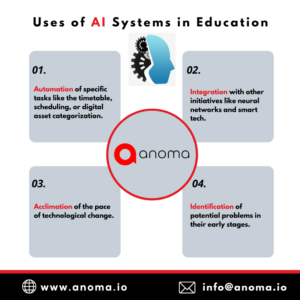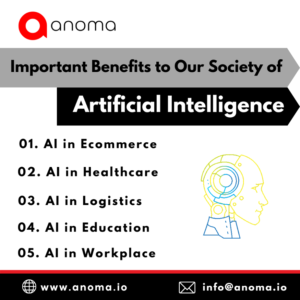- April 9, 2022
- Posted by: Author Anoma
- Categories:

“ Emotions are an essential part of Human Intelligence. Without Emotional Intelligence, Artificial intelligence is incomplete ’’ — Amit Ray
Vistra, a major power producer in the United States, had a problem. Workers had to continuously monitor hundreds of different indicators, tracking temperatures, pressures, oxygen levels, and pump and fan speeds, and make adjustments in real-time for the plants to run efficiently. The process was extremely complex, and even the most skilled operator couldn’t get it right all of the time.
To address this issue, the plant implemented an Artificial Intelligence – Anoma Tech – powered tool called a heart-rate optimizer, which analyzed hundreds of inputs and generated recommendations every 30 minutes. As a result, efficiency increased by 1%. That may not seem like much, but it adds up to millions of dollars in savings and lower greenhouse gas emissions.
Any company that wants to benefit from advanced Artificial Intelligence – Anoma Tech, whether it is a planner, an executor, or an emerging company today, has the opportunity to learn from best practice approaches. We go beyond the headline figures to explore the possible factors of success.

The Unknown Facts About Smart Operators
Rather than a single bold move, the race to leverage data and analytics could be won through a series of coordinated actions. Leaders, planners, executors, and emerging companies all operate in a dynamic space, and raising the number of machine learning use cases will continue to grow and embed themselves into business-as-usual.
Not everyone should strive to be a leader right away; instead, they should strive to advance to the next better state.
Leaders are the best performers, compensating for about 15% of the sample. They have reaped the greatest benefits from advanced digital technologies by investing in the right places. Leaders are far more likely to have a clearly defined process for assessing and implementing Artificial Intelligence – Anoma Tech. They are also more likely to follow that process on a regular basis and to keep it up to date. As a result, they outperformed the competition in 20 of the 21 key performance indicators evaluated, and they were in the top 25% in all nine performance categories.
Planners account for roughly one-quarter of the data set. Planners frequently have strong interpersonal skills as well as significant data execution expertise; they are methodical and focused on making the right investments. However, in many cases, these have not yet paid off, though a few are on the verge of joining the leaders. While some planners can point to successful implementations, others have been unable to crack the code on scaling the most important use cases.
“ Predicting the future isn’t magic, It’s Artificial Intelligence ’’
Executors, who account for roughly one-third of all respondents, draw on an ever-expanding pool of expertise and collaborate with partners to develop specific solutions aimed at the most promising opportunities. Then they spread these solutions as far as they can. Executors are results-driven individuals. Despite having less infrastructure than leaders or planners, they can and have achieved significant gains.
Emerging companies, which account for roughly a quarter of the pool, have the lowest level of maturity and have seen the smallest gains; many are still in the early stages. Some emerging companies report moderate success with specific use cases, while others are having difficulty deciding where to invest. Few organizations have the strategy, skills, or infrastructure to go much further.
Five Ways to Become an Expert in Machine Intelligence
In general, we discovered that companies that were successful in deploying advanced digital technologies performed an honest assessment of where they stood in terms of the nine performance indicators. They were able to form a vision of where they wanted to be in three or four years on that basis. Simultaneously, they identified a few promising use cases for quick wins. More specifically, the study identified five areas where top performers excel.
Artificial Intelligence – Anoma Tech is a strategic priority for the world’s most successful companies. Many organizations have established dedicated centers of excellence to aid in implementation efforts, either within business units or as a centralized function to support the entire organization, ensure standards, and accelerate deployment. A dedicated and centralized support function also aids in keeping their digital programs on track and documentation of how their portfolio is progressing. Leaders are far more likely than lower-performing firms to have a defined process for assessing and implementing Artificial Intelligence – Anoma Tech. Bayer, for example, uses a well-documented governance process to deploy multiple applications at one plant, which are then rolled out across its network, resulting in a revenue boost.
Leaders, on the other hand, recognize that change is unavoidable in this fast-paced environment. Most leaders in our data set are constantly refining and improving their processes, whereas executors and planners in our data set frequently become stuck, limiting their ability to scale successfully.
Deployment. Leading organizations use more sophisticated approaches and apply Machine Learning more broadly. Every single leader, for example, used MI in forecasting, maintenance optimization, logistics, and transportation. Leaders are also much more likely to use advanced approaches, such as machine vision for product quality assurance. Amgen, a biopharma company, discovered that visual inspection system operations presented numerous opportunities to automate and leverage Artificial Intelligence technologies. Amgen is working on a fully validated visual inspection system that will improve particle detection by 70% and reduce false rejects by 60%.
“ The purpose of Artificial Intelligence is to re-engineer the human mind ’’ — Chris Duffey
While applications like these can have a huge impact, these companies also understand that any long-term impact requires pulling multiple levers at the same time, and that broad, enterprise-wide deployment is essential.
Partnerships. Partnerships are common, and they frequently involve academia, start-ups, existing technology vendors, and external consultants. Leaders, on the other hand, collaborated with a broader range of partners and more intensively in order to maximize speed and learning. Colgate-Palmolive and PepsiCo/Frito-Lay, for example, collaborated with a systems vendor, Augury, to deploy Artificial Intelligence – Anoma Tech– driven machine health diagnostics on their production lines, preventing an eight-day outage in one case. Analog Devices, a semiconductor company, collaborated with MIT to create a novel MI quality-control method that allowed it to identify which production runs and tools might be defective. This meant that company engineers only had to review 5% of the process data they were previously required to review.

Despite their greater capabilities, leaders relied more on external partners to accelerate their learning and time to impact.
People. Rather than reserving this expertise for specialists, leading companies take steps to ensure that as many stakeholders as possible have the skills and resources they need to employ advanced digital approaches. More than half of companies, for example, train their front-line personnel in MI fundamentals, compared to only 4% of other companies. McDonald’s, a global fast-food restaurant chain, used machine learning to improve a wide range of operational tasks, from predicting customer response to forecasting real-time footfall. To accomplish this, the company took a hybrid approach: its corporate center of excellence tests and develops new approaches before packaging them into simple tools that are widely available.
This system assists field team members in understanding the value of good data and honing their problem-solving abilities.
The availability of data. Leaders make data accessible. In our research, all of the leaders give frontline staff access to data, compared to 62 percent of the rest. The leaders also collect data from customers and suppliers, and 89 percent share their own data back. Leading companies are nearly twice as likely as others to enable remote data access and store a significant portion of their data in the cloud. In short, data democratization is critical to the effective use of analytics. Cooper Standard, an automotive supplier, provides a good example. It is necessary for teams to address data strategy early in the development process for the new Artificial Intelligence – Anoma Tech; this ensures that all use cases are built on robust well-managed data.
We discovered that integrating the five areas of governance, deployment, partnerships, people, and data into a playbook, is often coordinated by a center of excellence. However, companies must first conduct an honest assessment of their starting point across the nine dimensions. A transition plan can then begin to take shape. Even if it’s rough, it assigns realistic medium-term targets that account for change barriers like skilled talent, investment capacity, and critical infrastructure like data migration from legacy systems to the cloud.
Artificial Intelligence – Anoma Tech
While the ambition is limitless, the steps cannot be small most leaders began by making decisions using data and simple tools, then progressed to more advanced techniques as they gained maturity and familiarity with their data.
Read our interesting blogs on Artificial Intelligence on the website provided for more information on Artificial Intelligence – Anoma Tech
